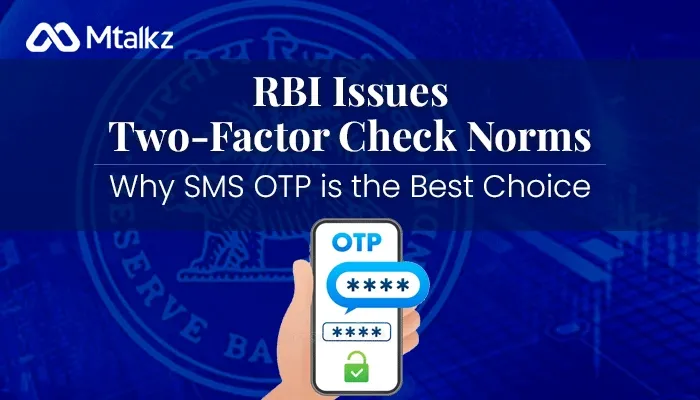
RBI Issues Two-Factor Check Norms: Why SMS OTP is the Best Choice
Why SMS OTP is the best choice for safeguarding digital transactions with its accessibility, speed, and security - RBI New 2FA norms
Abhishek Prakash
•Strategic sales leader with deep focus on customer relationship building and revenue growth. With over two decades of experience at corporates like IBM, Bharti Airtel, and Reliance Jio, driving excellence in enterprise profitability and competitive advantage.
RBI Issues Two-Factor Check Norms:
Why SMS OTP is the Best Choice In an era where cybersecurity threats are evolving rapidly, the Reserve Bank of India (RBI) has taken a significant step to safeguard digital transactions by issuing stringent two-factor authentication (2FA) norms. These new regulations mandate enhanced security measures for online transactions, aiming to protect users from potential fraud and unauthorized access. Among the various methods of implementing 2FA, SMS One-Time Password (OTP) stands out as a reliable and effective choice. Here's why SMS OTP is the preferred option for securing online transactions.2FA norms require all digital transactions to be authenticated using two separate methods, ensuring an added layer of security. This means that in addition to the usual login credentials, users must provide a second form of verification to complete a transaction.
This could be a fingerprint, a security token, or an OTP sent to the user's registered mobile number. The primary objective of these norms is to minimize the risk of fraud and to provide a secure banking environment for consumers. With the rapid increase in online banking and digital payment services, implementing robust security measures is imperative.
1. Wide Accessibility
SMS OTP is universally accessible. Unlike other methods that may require specific hardware or software, SMS OTP can be received on any mobile phone, regardless of the model or operating system. This makes it an inclusive solution, especially in a diverse country like India where smartphone penetration is still growing.
3. Ease of Use
SMS OTPs are user-friendly and do not require any technical know-how. Users simply need to enter the OTP received on their mobile phone to authenticate a transaction. This simplicity makes it a preferred choice among users of all age groups and technological proficiency levels.
5. Cost-Effective
For businesses, implementing SMS OTP is a cost-effective solution. There is no need for additional hardware or extensive software integration. Most mobile service providers offer bulk SMS services at competitive rates, making it an affordable option for companies to enhance their security measures.
Best Practices To ensure the effectiveness of SMS OTP, businesses should adhere to the following best practices.
- Timely Delivery:
3. Ease of Use
SMS OTPs are user-friendly and do not require any technical know-how. Users simply need to enter the OTP received on their mobile phone to authenticate a transaction. This simplicity makes it a preferred choice among users of all age groups and technological proficiency levels.5. Cost-Effective
For businesses, implementing SMS OTP is a cost-effective solution. There is no need for additional hardware or extensive software integration. Most mobile service providers offer bulk SMS services at competitive rates, making it an affordable option for companies to enhance their security measures.Best Practices To ensure the effectiveness of SMS OTP, businesses should adhere to the following best practices.
- Timely Delivery:
Partner with reliable SMS service providers to ensure that OTPs are delivered promptly.
- Short Validity Period:
Keep the OTP validity period short (typically 5-10 minutes) to reduce the risk of interception.
- User Education:
Educate users about the importance of not sharing OTPs with anyone and recognizing phishing attempts.
- Secure Transmission:
Use encryption to secure the transmission of OTPs from the server to the user's mobile device.